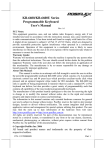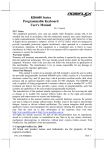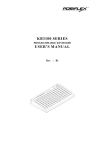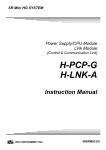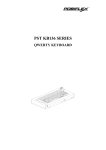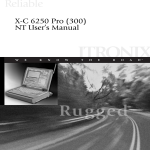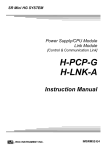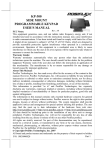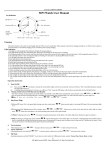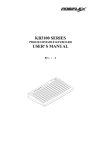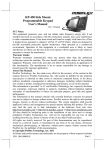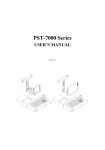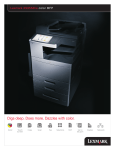Download POSIFLEX Business Machines KB3200 User's Manual
Transcript
KB3200 SERIES
136 - KEY QWERTY
PROGRAMMABLE KEYBOARD
USER’S MANUAL
Rev. : A1
LLPP
LL44
PPOO
MMSS
WWEE
LLOO
NNUU
LL33
RR
LLOO
CCAA
RR
LL00
11
LL22 LL
CCKK
PPSS
CCKK
MM
9
Up
Pg
8
7
me
Ho
6
5
3
4
+
||
=
\\
_
)
(
’
$
>
M
H
R
3
G
B
E
2
F
V
W
1
D
C
Q
‘
S
X
Ta
b
A
ps
Ca CK
LO
Z
t
if
Sh
rl
Ct
.
<
N
#
@
!
~
t
Al
?
L
K
J
T
4
;
I
U
Y
0 ns
t I
if
Sh
"
rl
Ct
:
O
8
7
6
r
te
En
[[
P
9
*
&
^
]]
{{
0
5
d
En
}}
-
%
2
1
,
t
Al
/
00
Dn
Pg
.
l
De
SOME IMPORTANT NOTES
FCC NOTES
This equipment generates, uses, and can radiate radio frequency energy and, if not installed
and used in accordance with the instructions manual, may cause interference to radio communications. It
has been tested and found to comply with limits for a Class A digital device pursuant to subpart J of Part
15 of FCC Rules, which are designed to provide reasonable protection against interference when
operated in a commercial environment. Operation of this equipment in a residential area is likely to cause
interference in which case the user at his own expense will be required to take whatever measures to
correct the interference.
WARRANTY LIMITS
Warranty will terminate automatically when the machine is opened by any person other than
the authorized technicians. The user should consult his/her dealer for the problem happened. Warranty
voids if the user does not follow the instructions in application of this merchandise. The manufacturer is
by no means responsible for any damage or hazard caused by improper application.
ABOUT THIS MANUAL
This manual is written in an attempt with full strength to assist the user to utilize the
powerful programmable keyboard KB-3200 series which consists of a 6 positioned electronic control key
and 136 press keys which provides excellent tactile click when pressed, and an optional magnetic stripe
reader for either ISO or JIS standards. The KB-3200 series not only is capable of being programmed to
transmit whatever code a standard PC or PS2 keyboard can deliver, but also provides a great variety of
programmability such that contains all capabilities of the most modern programmable keyboards.
The manufacturer of this product heartily apologizes to the user for reserving the right to
change or to modify this manual without notice due to the rapid and constant progress and improvement
on science and technology.
© Copyright Mustek Corp. 1999
All rights are strictly reserved. No part of this documentation may be reproduced, stored in a retrieval
system, or transmitted in any form or by any means, electronic, mechanical, photocopying, or otherwise,
without the prior written consent of Mustek Corp. the publisher of this documentation.
TRADE MARKS AND SERVICE MARKS
POSIFLEX is a registered trademark of Mustek Corp..
Other brand and product names are trademarks and registered trademarks and service marks
of their respective owners.
TABLE OF CONTENTS
OVERVIEW . . . . . . . . . . . . . . . . . . . . . . . . . . . . . . . . . . . . . . . 1 - 1
SCOPE . . . . . . . . . . . . . . . . . . . . . . . . . . . . . . . . . . . . . . . 1 FEATURES . . . . . . . . . . . . . . . . . . . . . . . . . . . . . . . . . . . 1 MODEL NUMBERS . . . . . . . . . . . . . . . . . . . . . . . . . . . . 1 ACCESSORIES . . . . . . . . . . . . . . . . . . . . . . . . . . . . . . . 1 OPTIONS . . . . . . . . . . . . . . . . . . . . . . . . . . . . . . . . . . . . . 1 STANDARD LAYOUTS . . . . . . . . . . . . . . . . . . . . . . . . . . . 2 FRANCE . . . . . . . . . . . . . . . . . . . . . . . . . . . . . . . . . . . . . 2 GERMANY . . . . . . . . . . . . . . . . . . . . . . . . . . . . . . . . . . . 2 ITALY . . . . . . . . . . . . . . . . . . . . . . . . . . . . . . . . . . . . . . . . 2 NETHERLANDS . . . . . . . . . . . . . . . . . . . . . . . . . . . . . . . 2 PORTUGAL . . . . . . . . . . . . . . . . . . . . . . . . . . . . . . . . . . . 2 SPAIN . . . . . . . . . . . . . . . . . . . . . . . . . . . . . . . . . . . . . . . . 2 SWEDEN/FINLAND . . . . . . . . . . . . . . . . . . . . . . . . . . . . 2 UNITED KINGDOM . . . . . . . . . . . . . . . . . . . . . . . . . . . . 2 UNITED STATES . . . . . . . . . . . . . . . . . . . . . . . . . . . . . . 2 INSTALLATION . . . . . . . . . . . . . . . . . . . . . . . . . . . . . . . . . . . 3 CABLE CONNECTION . . . . . . . . . . . . . . . . . . . . . . . . . 3 UTILITY INSTALLATION . . . . . . . . . . . . . . . . . . . . . . . 3 PROGRAMMING THE KEYBOARD . . . . . . . . . . . . . . . . 4 HOT KEY PROGRAMMING . . . . . . . . . . . . . . . . . . . . . 4 PREPARATION . . . . . . . . . . . . . . . . . . . . . . . . . . . . 4 ENTER “HOT KEY PROGRAMMING” MODE . . . 4 INPUT THE CONTENT TO BE PROGRAMMED . 4 EXIT “HOT KEY PROGRAMMING” MODE . . . . 4 PROGRAMMING UTILITY (KBM.EXE) . . . . . . . . . . . . 4 QUICK REFERENCE GUIDE . . . . . . . . . . . . . . . . 4 ANSWER BACK CODE . . . . . . . . . . . . . . . . . . . . . . 4 HARDWARE LIMITATION . . . . . . . . . . . . . . . . . . 4 PROGRAMMING UTILITY (KBW.EXE) . . . . . . . . . . . 4 SHORTCUT UTILITY (RWM.EXE) . . . . . . . . . . . . . . . . 4 -
1
1
2
3
3
1
1
2
2
3
3
4
4
5
5
1
1
2
1
1
1
2
2
3
4
4
4
5
5
6
i
APPLICATION . . . . . . . . . . . . . . . . . . . . . . . . . . . . . . . . . . . . 5 - 1
KEYBOARD CONSTRUCTION . . . . . . . . . . . . . . . . . . 5 LED’S . . . . . . . . . . . . . . . . . . . . . . . . . . . . . . . . . . . . . . . . 5 6 POSITION KEY-LOCK . . . . . . . . . . . . . . . . . . . . . . . . 5 PUSH KEY SWITCH AREA . . . . . . . . . . . . . . . . . . . . . 5 KEY TOP REPLACEMENT . . . . . . . . . . . . . . . . . . . . . . 5 MAGNETIC STRIPE READER SLOT . . . . . . . . . . . . . 5 PRELOADED PATTERN . . . . . . . . . . . . . . . . . . . . . . . . 5 WIN NT APPLICATION . . . . . . . . . . . . . . . . . . . . . . . . . 5 SPECIFICATIONS . . . . . . . . . . . . . . . . . . . . . . . . . . . . . . . . . 6 CONSTRUCTION . . . . . . . . . . . . . . . . . . . . . . . . . . . . . . 6 CASE MATERIALS . . . . . . . . . . . . . . . . . . . . . . . . . . . . 6 LED COLOR . . . . . . . . . . . . . . . . . . . . . . . . . . . . . . . . . . 6 KEY SWITCH TYPE . . . . . . . . . . . . . . . . . . . . . . . . . . . . 6 KEY STROKE TRAVEL . . . . . . . . . . . . . . . . . . . . . . . . . 6 KEY TOP SIZE . . . . . . . . . . . . . . . . . . . . . . . . . . . . . . . . 6 PREPRINTED KEYS . . . . . . . . . . . . . . . . . . . . . . . . . . . 6 KEY CAP . . . . . . . . . . . . . . . . . . . . . . . . . . . . . . . . . . . . . 6 PROGRAMMABILITY . . . . . . . . . . . . . . . . . . . . . . . . . . 6 POSITION CONTROL KEY . . . . . . . . . . . . . . . . . . . . . . 6 OUTPUT INTERFACE . . . . . . . . . . . . . . . . . . . . . . . . . . 6 MAGNETIC STRIPE READER . . . . . . . . . . . . . . . . . . . 6 READER SPECIFICATION . . . . . . . . . . . . . . . . . 6 CARD DATA FORMAT . . . . . . . . . . . . . . . . . . . . . . 6 POWER CONSUMPTION . . . . . . . . . . . . . . . . . . . . . . . 6 MECHANICAL . . . . . . . . . . . . . . . . . . . . . . . . . . . . . . . . . 6 ENVIRONMENTAL . . . . . . . . . . . . . . . . . . . . . . . . . . . . . 6 RELIABILITY INFORMATION . . . . . . . . . . . . . . . . . . . 6 APPLICABLE CONFORMITY . . . . . . . . . . . . . . . . . . . . 6 -
ii
1
1
2
3
4
6
7
8
1
1
1
1
1
1
1
1
1
1
2
2
3
3
4
4
4
4
4
4
I.
OVERVIEW
A. SCOPE
The KB3200 series is a powerful programmable keyboard suitable
for application in both IBM PC compatible system and PS2 compatible
system. It is programmable without TSR under DOS, Windows 3.1 and
also Windows95/98/NT environment. This series possesses a 6 position
control key which is capable of sending answer back codes according to
the position of the key. The KB3200 series provides in the lower part a
“QWERTY” keyboard that resembles the standard PC keyboard and at
the top a matrix of 3 by 17 locations for freely programming purpose.
Nevertheless, there are 2 more programmable keys within the
“QWERTY” region. The “QWERTY” region is available for layout of
various countries. Should there be any further question, please visit our
web site. (http://www.posiflex.com.tw)
B. FEATURES
l A 6 position control key to provide security lock, multiple page
controller and answer back code control
l Provided in lower 5 rows of the matrix are “QWERTY” keyboard,
numerical keypad and 2 programmable keys for each country
l Provided in upper 3 rows of the matrix with powerful
programmability (hot key programming, programming under DOS,
off-line programming under DOS, programming under Windows,
multiple page, multiple level, whole range key content, time delay,
position sense answer back code, etc.)
l Total memory for keys to be programmed: 8 KB
l Base structure of a 8 by 17 matrix
l 100% true spill-proof construction
l Reliable and pleasant key click
l Extension keyboard connector
l Comfortable key size
l Alternative double key
KB3200 Series User’s Manual
1-1
l Optional MSR (Magnetic Stripe Reader), soft dust cover
l Indication LED's includes Power, MSR, Cap-Lock and Num-Lock
l Wear resistant Laser marked numeric and QWERTY keys
C. MODEL NUMBERS
• KB3200xx
Basic model, non-volatile memory 8 KB
• KB3200xxM2
with MSR (ISO tracks 1 & 2)
• KB3200xxM2/3
with MSR (ISO tracks 2 & 3)
• KB3200xxM3
with MSR (ISO tracks 1, 2 & 3)
• KB3200xxMJ
with MSR (JIS I track 2 + JIS II)
In the above, “xx” represent one of the following 2-character
codes which means the variety in the QWERTY portion for
different languages.
xx
Language
FR
French
GR
Germany
IT
Italy
NL
Netherlands
PO
Portugal
SP
Spain
SV
Sweden/Finland
UK
United Kingdom
US
United States
NOTE: PS/II or PC interface selectable.
1-2
KB3200 Series User’s Manual
D. ACCESSORIES
•
•
•
•
•
•
•
•
•
Cable CCBLA-055-2
Cable CCBLA-055-1
Legend sheet
Double key cap
Single key cap
Blank key
Control keys
Utility software diskette
User’s manual
Key clip
x 1 for AT KB interface or
x 1 for PS/2 KB interface
x4
x1
x 52
x2
4 pcs per set
x1
x1
x 1 (mounted at bottom)
E. OPTIONS
•
•
•
•
•
MSR (ISO track 1 & 2, ISO track 2 & 3, ISO track 1, 2 &3,
or JIS I track 2 + JIS II) / pc
Double key / pc
Blank key / pc
Single key top & key cap / set
Off centered single key top & key cap / set
KB3200 Series User’s Manual
1-3
II.
STANDARD LAYOUTS for
QWERTY REGION
l
l
l
l
l
l
l
l
l
FRANCE
GERMANY
ITALY
NETHERLANDS
PORTUGAL
SPAIN
SWEDEN/FINLAND
UNITED KINGDOM
UNITED STATES
A. FRANCE
-
+
*
ESC
²
Num
Lock
1
2
3
4
5
6
7
8
9
&
é
~ "
# '
{ (
[ -
¦ è
` _
\ ç
A
|
Z
E
R
T
Y
U
I
°
+
^ à @ )
0
] =
O
P
|
Q
ñ
Ctrl
2-1
S
W
ÿ
D
X
Alt
F
C
G
V
H
B
J
N
K
L
M
¨
£
^
$
9
4
5
6
2
3
00
.
Entrée
µ
1
ù
*
Fin
.
/
§
>
,
;
:
!
<
ÿ
8
%
?
Alt Gr
7
}
ñ
Ctrl
0
Inser
Suppr
S/TL TTL
KB3200 Series User’s Manual
B. GERMANY
-
+
*
ESC
Num
Lock
°
!
"
§
$
%
&
/
(
)
=
?
`
^
1
2
² 3
³ 4
5
6
7
{ 8
[ 9
] 0
} β
\ ´
Q
|
|
W
E
R
T
Z
U
I
O
P
Ü
ñ
S
Y
X
F
C
G
V
H
B
J
N
K
M
L
;
µ ,
ÿ
Strg
D
Alt
Ö
Ä
:
_
>
.
_
<
Alt Gr
Bild
5
6
'
1
2
3
#
Ende
~
ñ
¦
ÿ
9
4
+
A
8
Pos1
*
@
ò
7
Strg
0
Bild
00
Einfg
.
Entf
S/TL TTL
C. ITALY
-
+
*
ESC
Num
Lock
¦
!
"
£
$
%
&
/
(
)
=
?
^
\
1
2
3
4
5
6
7
8
9
0
'
ì
Q
|
W
E
R
T
Y
U
I
O
P
|
A
ñ
Ctrl
S
Z
D
X
F
C
G
V
H
B
J
N
K
M
L
;
,
ÿ
Alt
KB3200 Series User’s Manual
:
.
Alt Gr
*
è
[ +
]
°
§
ò
@à
# ù
>
_
ÿ
8
9
4
5
6
1
2
3
Pag
é
ç
_
7
<
Ctrl
Invio
Fine
ñ
0
Pag
00
Ins
.
Canc
S/TL TTL
2-2
D. NETHERLANDS
-
+
*
ESC
§
Num
Lock
!
"
#
$
%
&
_
(
)
'
?
~
@ ¬1
¹ 2
² 3
³ 4
¼ 5
½ 6
¾ 7
£ 8
{ 9
} 0
/
\ °
Q
|
W
E
R
T
|
Y
U
I
O
P
¶
A
Caps
Lock
S
D
F
G
H
J
K
L
ñ
Z
C
«
ÿ
Ctrl
X
V
»
B
N
M
;
µ ,
¢
Alt
^
¦
¨
*
±
+
ß
2
3
1
End
.
]
Alt Gr
6
<
[
¦
ÿ
ñ
Ctrl
PgUp
5
>
_
9
4
´
=
8
Home
`
:
·
7
¸
0
PgDn
00
Ins
.
Del
S/TL TTL
E. PORTUGAL
-
+
*
ESC
Num
Lock
¦
!
"
#
$
%
&
/
(
)
=
?
»
7
\
1
2 @ 3
£ 4
§ 5
6
7
{ 8
[ 9
] 0
} '
«
Home
Q
|
W
E
R
T
Y
U
I
O
P
|
Caps
Lock
ñ
Ctrl
2-3
A
S
Z
D
X
F
C
G
V
H
B
J
N
K
M
L
;
,
ÿ
Alt
Ç
:
.
Alt Gr
*
`
+
¨ ´
2
3
1
~
End
<
ÿ
6
^
_
ñ
Ctrl
PgUp
5
º
>
9
4
ª
_
8
0
PgDn
00
Ins
.
Del
S/TL TTL
KB3200 Series User’s Manual
F. SPAIN
-
+
*
ESC
Num
Lock
ª
!
º
\ 1
·
$
%
&
/
(
)
=
?
¿
7
¦ 2 @ 3
"
# 4
5
6
¬ 7
8
9
0
'
¡
Inicio
Q
|
W
E
R
T
Y
U
I
O
P
|
A
Bloq
Mayú s
ñ
S
F
G
H
J
K
L
Ñ
*
`
[ +
Z
X
C
V
B
N
M
;
,
Alt
_
>
.
_
<
Alt Gr
}
{
:
Re Pág
4
5
6
1
2
3
Fin
ñ
ÿ
9
]
Ç
¨
´
ÿ
Ctrl
D
^
8
Ctrl
0
Av Pág
00
Ins
.
Supr
S/TL TTL
G. SWEDEN/FINLAND
-
+
*
ESC
Num
Lock
½
!
"
§
1
2 @ 3
Q
|
#
W
£ 4
E
R
%
&
/
(
)
=
?
`
$ 5
6
7
{ 8
[ 9
] 0
} +
\ ´
T
Y
U
I
O
P
Å
ñ
Ctrl
S
Z
D
X
F
C
G
V
H
B
J
N
K
M
L
;
,
ÿ
Alt
KB3200 Series User’s Manual
Ö
:
.
Alt Gr
Ä
_
>
_
<
ÿ
9
PgUp
4
5
6
*
1
2
3
'
End
¨
A
8
Home
^
|
Caps
Lock
7
~
¦
Ctrl
ñ
0
PgDn
00
Ins
.
Del
S/TL TTL
2-4
H. UNITED KINGDOM
-
+
*
ESC
Num
Lock
¬
!
"
£
$
%
^
&
*
(
)
_
+
7
`
|1
2
3
4
5
6
7
8
9
0
-
=
Home
Q
|
W
E
R
T
Y
U
I
O
P
|
A
Caps
Lock
ñ
S
Z
ÿ
Ctrl
D
X
F
C
G
V
H
B
J
N
K
M
L
{
}
[
]
3
1
#
End
,
.
/
\
Alt Gr
2
~
'
¦
Alt
6
@
?
ñ
ÿ
Ctrl
PgUp
5
;
>
9
4
:
<
8
0
PgDn
00
Ins
.
Del
S/TL TTL
I. UNITED STATES
-
+
*
ESC
Num
Lock
~
!
@
#
$
%
^
&
*
(
)
_
+
7
`
1
2
3
4
5
6
7
8
9
0
-
=
Home
Tab
Q
|
W
E
R
T
Y
U
I
O
P
|
Caps
Lock
ñ Shift
Ctrl
2-5
A
S
Z
ÿ
D
X
Alt
F
C
G
V
H
B
J
N
K
M
L
}
¦
[
]
\
:
"
;
'
<
>
?
,
.
/
Alt
{
ÿ
Enter
ñShift
Ctrl
8
9
PgUp
4
5
6
1
2
3
End
0
PgDn
00
Ins
.
Del
S/TL TTL
KB3200 Series User’s Manual
III. INSTALLATION
A. CABLE CONNECTION
Take the cable CCBLA-055-2 out of the accessory bag. Connect
the 6 pin DIN male plug of the cable to the 6 pin DIN female connector
at the left of the bottom of the programmable keyboard. Connect the
other end (5 pin DIN male plug) to the PC or a compatible system.
Connect the PC keyboard or any other keyboard wedged input device
such as a CCD scanner to the 5 pin DIN female connector at the bottom
of the programmable keyboard if such connection is required.
For installation in a PS2 or a compatible system with a PS2
interface type KB3200, the cable in the accessory bag should be
CCBLA-055-1. Connect the mini DIN 6 male plug of the cable to the
PS2 or a compatible system. Do all the rest just like that for PC.
PC or PS2
Monitor
PC or PS2 KB
CCBLA-055-2 or
CCBLA-055-1
KB3200 Series User’s Manual
KB-3200
3-1
B. UTILITY INSTALLATION
There are in total three methods to program the programmable
keys in KB3200 series keyboard: “RWM.EXE” the straightforward
direct read/write programming utility; “KBM.EXE” the normal
programming utility and the “Hot Key Programming” most suitable to
modify the key contents of one or two keys. Installation procedures are
required for utilities “KBM.EXE” and “RWM.EXE”.
In the utility diskette, there is a file named “INSTALL.EXE” for
installation of all the utilities into any operating system among Windows
95/98/NT, Windows 3.1 and DOS. The user may install the
programming utility by following the step by step instructions from this
executable program. The user may refer to the information on our web
site for a preview of this program.
A new programming utility that is referred to as “KBW.EXE” in
this manual is developed particularly for the Windows 95/98/NT
environment. If the KB3200 series is delivered with the new
programming utility, please copy the files to a suitable subdirectory of
the system and double click the “Setup” program to install the whole
utility. After completion of the “Setup”, there will be a program group
“Posiflex KB Utility for Win 95&98&NT” in the program files. There
will be 2 programs “Posiflex Keyboard Utility KBM” and “Posiflex
Keyboard Utility KBW” in this group. The “Posiflex Keyboard Utility
KBM” is referred to as the KBM.EXE in this manual and the “Posiflex
Keyboard Utility KBW” is referred to as the KBW.EXE in this manual.
The KBM programs the keyboard in a more well known direct method
while the KBW programs the keyboard in a Windows approach.
3-2
KB3200 Series User’s Manual
IV. PROGRAMMING THE KEYBOARD
A. HOT KEY PROGRAMMING
The KB3200 series programmable keyboard, when connected with
a standard PC or PS/2 keyboard, supportS the “hot key programming”
method which is most useful in instant modification of a few keys in a
preprogrammed keyboard without entering the more sophisticated
programming utility. Of course, the user may also use this feature to
program through out all programmable keys by 5 pages (LP and L1 to
L4) on KB3200 series at will. The whole process of “hot key
programming” contains 4 steps for each key to be programmed and is
illustrated as following:
Preparation
Enter “hot key
programming”
mode
Input the
content to be
programmed
Exit “hot key
programming”
mode
1. PREPARATION
To enable “hot key programming” feature of the programmable
keyboard, a standard PC or PS/2 keyboard must be connected to the
external KB connector of the programmable keyboard before entering
“hot key programming” mode. The user shall then decide which key of
which page is to be programmed and turn the 6 position control key to
the proper position before entering the “hot key programming” mode.
Please note that the 2 programmable keys in the numerical keypad in
KB3200 series and the answer back codes of the position control key in
both series are not covered by the “hot key programming” feature.
KB3200 Series User’s Manual
4-1
2. ENTER “HOT KEY PROGRAMMING” MODE
To enter the “hot key programming” mode, the user must input the
“hot key” and identify the key on the programmable keyboard to be
programmed. The so-called “hot key” is a special combination of keys
pressed on the standard PC or PS-2 keyboard. In KB3200 series, the “hot
key” is defined as pressing and holding the left “Alt” key while pressing
the “PRT SC” (“Print Screen”) key on the PC or PS-2 keyboard. And by
doing so, the programmable keyboard will give 2 beeps to notify that it is
ready to receive the identification of which key to be programmed. Right
after the “hot key” is released, the user shall press the key to be
programmed on the programmable keyboard once to identify which key
to be programmed. If the “hot key” is pressed for the second time or the
“Esc” key is pressed prior to the press of the key on the programmable
keyboard, this mode will be aborted immediately. The user should not
enter the “hot key programming” mode when the programmable
keyboard is already fully loaded (no more free memory for further
programming) by the key contents previously programmed.
3. INPUT THE CONTENT TO BE PROGRAMMED
Once the programmable keyboard enters the “hot key
programming” mode with the key to be programmed identified, what the
user types on the standard PC or PS-2 keyboard will be taken for the
content to be programmed into that key of the programmable keyboard
till the user exits the “hot key programming” mode.
The legal input in this mode includes all alphabetical letters
(including both upper and lower cases), numerical digits (applicable
only for keys at the area above the alphabetical keys and excluding those
on the numerical keypad), symbols (such as `!”#$ and excluding those
arithmetic signs in the numerical keypad) and the “enter” key. The
“shift” key, the “caps lock” key and the “back space” key are also
accepted in this mode to serve an editing purpose (for example, pressing
“back space” will erase the last character of the input instead of being
treated as a character for input). Pressing the “Esc” key in this mode will
abort the “hot key programming” mode immediately. All the rest keys
4-2
KB3200 Series User’s Manual
such as the “Ctrl”, “Alt”, “Home”, any function key or arrow key or any
key in the numerical keypad) on the standard PC or PS-2 keyboard are
illegal inputs in this mode. The maximum number of key presses
acceptable to any key by “hot key programming” is 32.
All the input from the standard PC or PS-2 keyboard in this mode
will also be sent to the host computer. Any key press from the predefined
programmable keyboard for data input in “hot key programming” is
prohibited.
4. EXIT “HOT KEY PROGRAMMING” MODE
After the intended content of the key is completely entered, the user
shall press the “hot key” again to notify the end of “hot key
programming”. The programmable keyboard will give one beep to
signify the normal exit of the “hot key programming” mode. Should
there be any illegal entry in the content of the key or any other improper
operation during the programming stage, the programmable keyboard
will give three beeps to signify the failure of “hot key programming” and
the key content is not changed. If the user pressed the “Esc” key to abort
“hot key programming”, the programmable keyboard will also give three
beeps immediately as a response to signify the abort.
KB3200 Series User’s Manual
4-3
B. PROGRAMMING UTILITY (KBM.EXE)
1. QUICK REFERENCE GUIDE
Please refer to our web site for every detail in programming these
programmable keyboards. The following simplified guide severs as a
concise tool for instant application.
Keys To Program
How to Program Them
Esc, F1 - F12, Back Space, Shift,
Ctrl, Alt, Insert, Delete, End, Page
Press: (Alt-N), Esc, “Desired Key”,
Up, Page Down, Print Scrn, Scroll
Down Arrow
Lock, Break, and all Arrow
Functions
A - Z, 0 - 9, ~ ` ! @ # $ % ^ & * ( Press: Enter, “Desired Key or Keys”,
) - _ = + } { [ ] | \ ’ ; ” : /. , < > ?
Down Arrow
Tab, Enter
Press: (Alt-N), “Desired Key”,
Down Arrow
Caps Lock
Press: Enter, (Alt-C), Down Arrow
Multishift
Press: (Alt-N), (Alt-M), Down
Arrow - - - - Press (Alt-M) as many
times as needed.
Seperator
In Between Any Text, Press (Alt-S)
Different Pages
Press: Page Up or Page Down - - - You'll see an indicator on the bottom
left, indicating to what page you are
on.
2. ANSWER BACK CODE
Programming the answer back codes of the 6 position electronic
key-lock is also very easy as they are included in the keyboard
4-4
KB3200 Series User’s Manual
programming with the locations coded as “KLP”, “KL0”, “KL1”,
“KL2”, “KL3” and “KL4” in the key-layout map of page L1. The
programmable keyboard will issue an answer back code to PC whenever
the 6 position electronic key is switched to a new position or when the
keyboard receives an “enquiry” code (E7h) from the host computer
system. A time delay as determined in the configuration of the keyboard
programming utility is adjustable by “r” and “t” key presses, this time
delay is useful to give only the answer back code of the last position of
control key when it is turned across several positions. Here are some
examples of sending this “enquiry” code in different languages:
Language
C
BASIC
DEBUG
Syntax
outp (0x60, 0xE7)
out &H60, &H0E7
o 60 E7
3. HARDWARE LIMITATION
In case of “multiple combination key” application which means
pressing three or more keys at the same time to obtain certain data output
from the keyboard, there could be some limitations inherent from the
nature of keyboard structure. The CPU of keyboard detects the contact
between the “horizontal” and “vertical” lines for each key press,
recognizes which key is pressed and sends correspondent data to the host
computer. When there are many keys pressed at the same time, and the
pattern of the contacts coincides with some special relationship, there are
chances that the CPU of keyboard be confused about exactly which keys
are pressed. The user may change the locations of the key-definition to
prevent this once such confusion happens.
C. PROGRAMMING UTILITY (KBW.EXE)
This utility programs the programmable keyboard as KBM.EXE
does but using Windows application interface. Please use on - line help
to program the programmable keyboard.
KB3200 Series User’s Manual
4-5
D. SHORTCUT UTILITY (RWM.EXE)
The feature of this RWM.EXE is designed mainly for the off-line
programming purpose and is very useful in quick reproduction of the
preprogrammed contents of the programmable keyboard. In such
application, the user should have either the preprogrammed keyboard or
the preprogrammed file with “.tpl” extension name which is the result of
the keyboard programming. The user may use RWM.EXE to directly
transfer the programmed result of the programmable keyboard to a “.tpl”
file or directly transfer a prestored “.tpl” file to a programmable
keyboard without entering the utility “KBM.EXE” which may take more
keystrokes. For instance, the user wants to transfer a file “XXX.tpl”,
which was saved before, to the programmable keyboard, he/she should
type in following command in subdirectory “POSIFLEX.D”:
RWM XXX.tpl
(enter)
This operation is quite recommended to be performed on a daily
basis to ensure the system stability.
On the other hand, when the user wants to save the contents of a
programmed keyboard, e.g. when he/she newly receives a programmable
keyboard, to a file named “YYY.tpl”, he/she should type in following
command in subdirectory “POSIFLEX.D”:
RWM –r YYY.tpl
(enter)
In this application, the user must be careful on the housekeeping of
these template files and never mix such files with those originated from
other programmable keyboard. In other words, transferring a file
generated from other programmable keyboard to KB3200 series could
mess up the data format inside KB3200 series, and vice versa.
4-6
KB3200 Series User’s Manual
V. APPLICATION
A. KEYBOARD CONSTRUCTION
The programmable keyboard is constructed of three parts on
top surface. A 6 position turning key switch area with LED’s is at
upper right corner, a push key switch area occupies most of the
surface and a left-right slot near the upper edge is designed for
Magnetic Stripe Reader options.
6 position key
Power-on LED
the
the
top
the
6 position key switch
MSR indicator
LLPP
LL44
RR
WWEE
PPOO
PPSS
CCAA
RR
MMSS
MM
NNUU
LL33
LL22
LL00
LL11
CCKK
LLOO
CCKK
LLOO
9
Up
Pg
8
7
me
Ho
6
5
3
4
++
Num Lock LED
||
==
\\
__
2
1
d
En
Dn
Pg
.
l
De
00
}}
-))
&&
,
M
rl
Ct
/
.
t
Al
Caps Lock LED
H
N
G
B
E
22
F
V
W
11
<
J
T
44
R
@@
!!
D
C
Q
‘
>
K
Y
55
?
L
U
66
~
’
;
I
77
^^
%%
$$
33
0
s
t In
if
Sh
"
:
O
88
##
[[
P
99
**
r
te
En
{{
00
((
]]
S
X
bb
Ta
Ta
A
Z
ps
ps
Ca
Ca CK
CK
LO
LO
t
Al
t
if
Sh
MSR slot
rl
Ct
17 x 8 key matrix
B. LED’s
In the rectangular area at upper right corner there are one 6
position electronic key switch and four LED’s. They are arranged as in
drawing below.
L4
MSR
POWER
L3
NUM LOCK
CAPS LOCK
TM
L2
L1
LP
LO
The top left LED is for MSR reading indication, the top right LED
is the power-on indicator, the bottom right LED is the Cap-Lock
KB3200 Series User’s Manual
5-1
indicator for the “QWERTY” keyboard and the bottom left LED is the
Num-Lock indicator of the numerical keypad.
For the “Caps Lock” or “Num Lock” LED at the bottom, the
function as of a normal standard PC or PS/2 keyboard applies if the
KB3200 series is operating alone without an external PC or PS/2
keyboard connected. When an external PC or PS/2 keyboard is
connected, pressing the “Caps Lock” key or the “Num Lock” key on the
PC or PS/2 keyboard will have both the correspondent LED’s on
KB3200 series and PC or PS/2 keyboard change status accordingly. Yet,
if it is the “Caps Lock” key or the “Num Lock” key on KB3200 series
pressed, only the correspondent LED on KB3200 series will change
while the LED on PC or PS/2 keyboard remain unchanged.
C. 6 POSITION KEY-LOCK
The programmable keyboard has a six position key switch which
may also be programmed so that as the position of the key switch is
changed with a key, the key switch reports its own position (adjustable
inter-position time delays are programmed in). Further more, an enquiry
code from the host will cause the key switch to report its current
position.
This 6 position key switch effectively provides a multi-layer
capability to the keyboard. each position of the key can define separate
key sequence for each programmable key. This gives rise to the concept
of pages, so that KB3200 can be said to have 5 pages of 51 key
definitions per page and additional 2 programmable keys in numerical
keypad area. Therefor, there are in total 257 possible key definitions
programmable.
There are 4 keys supplied with each keyboard and the lock is so
designed that certain keys may only be turned to certain positions. This
architecture is similar to that found in many high end ECR systems, so it
is not surprising that the naming conventions have been borrowed as
well.
The keys are named: PRG, REG, Z, GT.
The switch positions are named: LP, L0, L1, L2, L3, L4. Among
these, the position L0 could also be referred to as “ ” which represents
5-2
KB3200 Series User’s Manual
a lock. The available positions for each key type are listed in the table
below.
O = access
X = no access
REG
PRG
Z
GT
LP
O
X
X
X
L0
O
O
O
O
L1
O
O
O
O
L2
O
O
O
O
L3
O
X
O
O
L4
X
X
X
O
The position L0 is designed to provide a “Security Lock-Off”
function. Keys may only be removed from positions L0 and L1.
POWER ON LED
LLPP
LL44
RR
WWEE
PPOO
PPSS
CCAA
RR
MMSS
MSR indicator
MM
NNUU
LL33
LL22
LL11
LL00
CCKK
LLOO
CCKK
LLOO
9
me
Ho
6
5
3
4
2
1
d
En
Dn
Pg
.
l
De
00
0
Num Lock LED
Caps Lock LED
Up
Pg
8
7
s
In
D. PUSH KEY SWITCH AREA
The major part on the keyboard surface is the push key switch
area. This area is basically constructed in a 17 x 8 matrix providing a
possibility of maximum 136 key positions available. However, the upper
17 x 3 matrix part remains in matrix and page dependent while the lower
part is organized in “QWERTY” format. This “QWERTY” format
portion, occupying an area of 5 whole rows, is country dependent and
KB3200 Series User’s Manual
5-3
page independent and possesses about 61 or 62 alphanumerical keys as
the layout dictates, 12 keys of numerical keypad and 2 programmable
keys. So there will never be a total number of the maximum possible 136
keys for any country throughout the KB3200 series.
The numerical keypad portion will function as arrow keys and
“Home”, “End”, “Ins” etc. like the numerical keypad on a standard PC or
PS/2 keyboard does if the “Num Lock” status is OFF. The marking on
the “QWERTY” keys and the numerical keys is non-erasable.
E. KEY TOP REPLACEMENT
In the push key switch matrix area, there are 17 by 3
programmable keys. Yet, there are chances that the user may want to
compromise some number of programmable keys for a larger key for
ease of operation. In such occasions, the user may purchase the double
key option, remove the single keys and insert the double key and
sometimes remove the double key for other arrangement. The user may
use a flat bladed screwdriver to remove the key tops. Please note that
there are two possible directions for a double key.
It is very important to correctly orientate the key tops before they
are inserted into the keyboard frame. Failure to do this could result in
5-4
KB3200 Series User’s Manual
permanent damage. Looking into the guide hole on the keyboard frame,
there is a tab inside the bottom side wall. Examining the bottom square
stem of a single key top, there is a springy latching tab on one side.
Checking the bottom of a double key top, there are two sides of the
matching stem (besides the patented balancing mechanism) constructed
with the springy latching tab.
Keyboard frame
Tab in the
guide hole
Key top
Double key top
Latching tab
Latching tab
Latching tab
When any key top is to be inserted onto the keyboard frame, the
tab on the inside wall of the key top guide hole must mate a
corresponding springy latching tab as illustrated above. In this way, the
matching stem of a double key must be either at the bottom when the
double key is “vertically” aligned or at the right of the key coverage area
when the double key is “horizontally” aligned. The location for the keydefinition to be programmed for the double key shall then be the bottom
or the right position accordingly.
KB3200 Series User’s Manual
5-5
F. MAGNETIC STRIPE READER SLOT
The MSR slot is near the upper edge of the Programmable
Keyboard. The MSR indicator LED is located at the upper left corner of
the block containing the electronic key. There are in total four choices of
the reader types – two types of ISO dual tracks, ISO triple tracks and JIS
types. For card reading, be sure to insert the card to the bottom with
magnetic stripe of ISO card or JIS I track 2 facing down. The movement
of an ISO card can be either inserting the card from the top surface at the
right end then sliding the card to the left out of the slot, or sliding the
card from the left of the slot till it reaches the right end of the slot. Yet
the movement of a JIS card is limited to the leftward movement, i.e.
inserting the card from the top surface at the right end then sliding the
card to the left out of the slot. The reverse movement of a JIS card is not
readable. The MSR indicator will light up in green when the MSR is
ready to read, blink during reading, and then give a green light if the
reading is successful. The MSR indicator will turn to be red if the
reading fails due to improper sliding or poor magnetic intensity of the
magnetic stripe, the MSR indicator will then turn back to green when the
MSR is again ready to read.
MSR INDICATOR
ISO card
POWER ON LED
Magnetic stripe
toward user
LLPP
LL44
PPOO
MMSS
WWEE
LLOO
NNUU
LL33
RR
LLOO
CCAA
RR
LL00
LL22 LL11
CCKK
PPSS
CCKK
MM
9
Up
Pg
8
7
MSR SLOT
me
Ho
6
5
3
4
+
|
=
\
_
]
)
~
rl
Ct
/
>
.
<
M
,
t
Al
H
N
R
G
B
E
F
V
W
D
C
Q
‘
?
L
K
J
T
4
3
2
1
l
De
’
;
I
U
Y
$
#
@
!
Dn
Pg
.
00
0 ns
t I
if
Sh
"
:
O
8
7
6
[
P
9
*
&
^
5
r
te
En
{
0
%
d
En
}
-
(
2
1
S
X
b
Ta
A
Z
ps
Ca CK
LO
t
if
Sh
t
Al
rl
Ct
READER HEAD MARK
Reading magnetic stripe cards of ISO standard
5-6
KB3200 Series User’s Manual
LLPP
LL44
PPOO
MMSS
WWEE
LLOO
NNUU
LL33
RR
LLOO
CCAA
RR
LL00
LL22 LL11
CCKK
PPSS
CCKK
MM
Up
Pg
9
8
7
me
Ho
6
5
3
4
+
|
=
-
]
*
&
;
?
L
.
<
J
,
M
T
4
rl
Ct
/
>
K
Y
$
#
@
t
Al
H
N
R
3
G
B
E
2
F
V
W
1
’
:
I
U
6
5
l
De
"
O
8
7
^
%
!
[
P
0 ns
t I
if
Sh
r
te
En
{
0
9
Dn
Pg
.
00
}
)
(
2
d
En
1
\
_
D
C
~
Q
‘
S
X
b
Ta
A
Z
ps
Ca CK
LO
t
Al
t
if
Sh
rl
Ct
Reading magnetic stripe cards of JIS standard
G. PRELOADED PATTERN
This keyboard is preloaded with some data in the “LP” page of the
programmable area as indicated below to help the user’s application at
the moment he/she receives this programmable keyboard.
-
Insert Home PgUp
Esc
F1
F2
F3
F4
F5
F6
F7
F8
Delete End
PgDn
F9
F11
F10
*
Print Scroll Pause Num
Screen Lock
Lock
F12
~
!
@
#
$
%
^
&
*
(
)
_
+
7
`
1
2
3
4
5
6
7
8
9
0
-
=
Home
Tab
Q
|
W
E
R
T
Y
U
I
O
P
|
Caps
Lock
ñ Shift
Ctrl
A
S
Z
ÿ
D
X
F
C
G
V
H
B
J
N
Alt
K
M
L
}
¦
[
]
\
"
;
'
<
>
?
,
.
/
Alt
{
:
ÿ
+
Enter
8
PgUp
4
5
6
1
2
3
End
ñShift
Ctrl
9
0
PgDn
00
Ins
.
Del
S/TL TTL
The preloaded pattern in pages “L1” to “L4” is as below. Please
note that the key definitions in the clear area can be reprogrammed by
the user at will. The user may reprogram these keys and create a label to
stick on such keys and cover it with the transparent key cap if he/she
KB3200 Series User’s Manual
5-7
wants to alter the contents of these Laser marked programmable keys.
The contents of S/TL and TTL keys remain empty because the internal
codes for these function are different per application programs.
-
+
*
Esc
Num
Lock
~
!
@
#
$
%
^
&
*
(
)
_
+
7
`
1
2
3
4
5
6
7
8
9
0
-
=
Home
Tab
Q
|
W
E
R
T
Y
U
I
O
P
|
Caps
Lock
ñ Shift
Ctrl
A
S
Z
ÿ
D
X
Alt
F
C
G
V
H
B
J
N
K
M
L
}
¦
[
]
\
:
"
;
'
<
>
?
,
.
/
Alt
{
ÿ
Enter
8
PgUp
4
5
6
1
2
3
End
ñShift
Ctrl
9
0
PgDn
00
Ins
.
Del
S/TL TTL
H. WIN NT APPLICATION
A preprogrammed Posiflex programmable keyboard can be used
normally under Win NT without any modification. In case of any
problem confronted by our Win NT user, the user is suggested to turn off
the PC, connect a PC/PS2 keyboard to the Posiflex programmable
keyboard and restart the system. Please then download a system file
“I8042PRT.SYS” from our web site download page:
www.posiflex.com.tw/english/download.htm under the category
of “PROGRAMMABLE KEYBOARD DRIVERS”. After a successful
download, please then rename the current system file I8042PRT.SYS in
subdirectory C:\WINNT\System32\Drivers\ into I8042PRT.BAK and
copy the downloaded file to this subdirectory and restart the system.
To program the Posiflex programmable keyboard in Win NT, the
customer is suggested to visit our web site:
http://www.posiflex.com.tw or go directly to the download page as
above for a most up-to-date software.
5-8
KB3200 Series User’s Manual
VI. SPECIFICATIONS
CONSTRUCTION:
100% true spill-proof structure, state of the
art top notch solid design with water
drainage system, 8 x 17 matrix structure
with a qwerty layout keyboard + 53
programmable
keys
+
6
position
programmable control key
CASE MATERIALS:
ABS
LED COLOR:
Power on - Green
MSR - Green & Red
Caps Lock - Green
Num Lock - Green
KEY SWITCH TYPE:
membrane plus rubber dome
KEY STROKE TRAVEL:3.2 mm
KEY TOP SIZE:
18 x 18 mm for individual key except the
qwerty portion
PREPRINTED KEYS:
Qwerty keys + Numeric keys + Basic
function keys
KEY CAP:
18 x 18 mm transparent
PROGRAMMABILITY:
• METHOD:
Software programming under DOS,
WINDOWS 3.1, WIN95, WIN98 or WIN
NT without TSR program
KB3200 Series User’s Manual
6-1
• COVERAGE:
•
•
•
•
•
•
•
•
•
53 keys by 5 pages + one keylock, total 6
position control answer back codes
CODE TYPE:
ASCII or scan codes
LANGUAGE:
English or European, software configured
CONTENTS LENGTH:
1 - 255 byte(s)/key
MULTILEVEL: 8 levels max.
MEMORY:
Non-volatile memory 8KB
INTERCHARACTOR OUTPUT SPEED FOR KB:
programmable 0 - 140 msec
COMMANDED TIME DELAY:
programmable 0 - 240 sec
ANSWER BACK DELAY TIME:
programmable 0 - 2 sec.
CONTROL KEY: 6 positions with position change answer
back function
POSITION CONTROL KEY:
• 6 positions (LP, L0, L1, L2, L3, L4), key extractable at L0 and L1
• Hardware lock off all keyboard data output after answer back
code sent at L0
• Capable of giving programmable answer back code on position
change of the key
• Capable of giving programmable answer back code of each
position on receiving a specific code inquiry (E7h) from host
computer
OUTPUT INTERFACE:
• 6 pin DIN female connector:
• 5 pin DIN female connector:
connects to host computer
connects to input PC
keyboard or Daisy Chain
devices
• 6 pin mini DIN female connector: connects to input PS2
keyboard
6-2
KB3200 Series User’s Manual
Connects to PC through CCBLA- Connects to PC keyboard Connects to
055-2 or CCBLA-055-1
or Daisy Chain devices PS2 keyboard
MAGNETIC STRIPE READER: (Models KB3200xxM2, KB3200xxM3,
KB3200xxM2/3, KB3200xxMJ)
• Decoder & interface.. Built-in keyboard wedge interface
• Tracks........................ ISO7811/2 tracks 1 & 2 (KB3200xxM2)
or
ISO7811/2 tracks 2 & 3 (KB3200xxM2/3)
or
ISO7811/2 tracks 1, 2 & 3 (KB3200xxM3)
or
JIS I/II (KB3100xxMJ for JIS X 6302)
• Start/end sentinels..... Can be disabled by hardware jumper on
ISO7811/2 MSR
a) Reader application
Applicable card type
ISO 7811/2
JIS X 6302
Card feed method
Manual
Manual
Card feed direction
Bi-direction
Uni-direction
Read / write function
Read only
Read only
Card feed speed
5 to 55 inches/sec. 100 ~ 1200 mm/sec.
Error rate
Less than 0.5%
Less than 0.1%
KB3200 Series User’s Manual
6-3
b) Card data format
Card standard
IATA
ABA
Track used
Track 1 Track 2
Recording method F2F (FM) F2F (FM)
Recording density 210 BPI 75 BPI
Recording capacity
79 / 7
40 / 5
characters / bits
THRIFT JIS I
JIS II
Track 3 Track 2 Rear side
F2F (FM) F2F (FM) F2F (FM)
210 BPI 75 BPI 210 BPI
107 / 5
40 / 5
72 / 7
POWER CONSUMPTION:
Voltage................................ 5VDC±10%
Current............................... 150 mA max. (Model KB3200xx)
200
mA
max.
(Models
KB3200xxM2,
KB3200xxM3,
KB3200xxMJ)
MECHANICAL:
Dimension in mm (inches)... 346 mm x 210 mm x 57 mm
(13.6”) x (8.3”) x (2.2”)
(W x D x H)
ENVIRONMENTAL:
Operating temperature........
Storage temperature............
Relative humidity.................
Vibration...........................…
Shock................................….
0°C to + 50°C
-20°C to + 70°C
90%, non-condensing
4G
40G
RELIABILITY INFORMATION:
• Push key switch: .............…. 15,000,000 strokes min.
• Memory: .........................…. 100 years min.
• MSR head life: ...............…. 300,000 passes min.
APPLICABLE CONFORMITY:
CE, FCC CLASS A
6-4
KB3200 Series User’s Manual


































